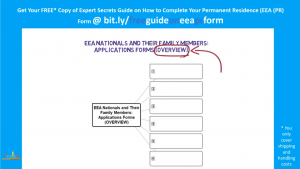Today’s post is about EU Citizens in the UK: Applications Forms (OVERVIEW)
Let me start by explaining WHY you need to watch this video. This is because if you are an EEA national or a family member of an EEA national and are thinking of making an application, one of the key elements of any application is to use the appropriate form:
The UKVI will consider all applications made after February 2017 under new 2016 Regulations. According to the new rules, the applications must be:
- made using the specified application form
- accompanied by the necessary supporting documents
- complete
Before February 2017 EEA nationals and their family members could submit their application without using any forms. They could just write a letter send it to the UK Immigration Authorities together with the supporting documents. And the Home Office considered applications despite the fact that they were not fully or correctly complete. Well, this is no longer the case. In order to be successful in any type of application now, EEA nationals and their family members should make sure that they are using the correct forms and following the correct procedures when submitting them.
The purpose of today’s video is to give you an overview of all the forms EEA nationals and their family members must use when submitting their applications.
There six main forms, which the EEA nationals and their family members can use when submitting their applications. In this video I’ll give you the names, I’ll show you how they look like and briefly what they are used for and in my future videos I’ll concentrate on each form separately explaining its purpose.
The Forms:
-
European Economic Area (EEA) family permit:
Who is this form for?
- For non-EEA national family members of an EEA nationals, who are outside the UK and wish to join or accompany their EEA national relative to the UK.
-

EU Citizens in the UK: Applications Forms Non-EEA nationals who have retained a right of residence in the UK and who are seeking to re-enter this country. I’ve created a very detailed video, explaining this particular category, please feel free watch this video if you need further information.
- For EEA national’s FM with a derivative right of residence in the UK. I’ll create a special video to explain this complex, but very powerful category.
- This form is also family members of British citizens who qualify under Surrinder Singh Route. There is a separate video where I explain this route.
- And finally you can use this form if you are a non-EEA national who have acquired a right of permanent residence in the UK and are outside of the UK and wish to re-enter the UK in order to make their permanent residence application.
This is an online application, unless you are from North Korea.
This is the only application form, which should be used by EEA national’s family members who are outside the UK. You can only use all other forms if you are in the UK.
-
Registration certificate as a qualified person
This form is for EEA nationals, who are recognised as qualified persons in the UK. In other words, the form can be used by EEA workers (including those who have retained their worker status), self-employed persons, self-sufficient persons, students and jobseekers. EEA nationals are under NO obligation to apply for this documents, as it merely confirms the rights they already have, but if they do choose to apply, they can do so by making the online application or using form EEA(QP).
-
Registration certificate or residence card as a direct family member
The application is for direct family members of an EEA nationals, who are recognised qualified persons in the UK (as I’ve mentioned before, qualified persons are workers, self-employed persons, self-sufficient persons, students and jobseekers). I’ve created videos explaining what a qualified person means and also explained the difference between direct and extended family members. Please do watch these videos as it is very important for you to understand these legal definitions before applying.
So, if you are a direct family members of an EEA national and you are an EEA national yourself, you should apply for a Registration Certificate.
If you are a Non-EEA national family member of your EEA national relative, you should apply for a Residence card. And EEA(FM) is the form to use.
-
Registration certificate or residence card as an extended family member
EEA(EFM) form is for extended family members of an EEA nationals, who are qualified persons. Non-EEA nationals extended family members will be applying for a residence card and EEA nationals will be applying for a registration certificate.
-
Derivative residence card
Is for those family members with derivative rights of residence in the UK. In other words, when you get (derive) your rights of residence in the UK from someone else’s rights. This type of application is mainly for primary carers of EEA nationals children (and British citizen children in some cases). I’ll create a separate video explaining this category for you. The form you’ll be using in this case is: form DRF1.
-
Document certifying a right of permanent residence or permanent residence card
EEA(PR) form is for those who want to apply for a document certifying their right of permanent residence in the UK. Alternatively, if you are a Non-EEA nationals family member, you will be applying for a permanent residence card.
